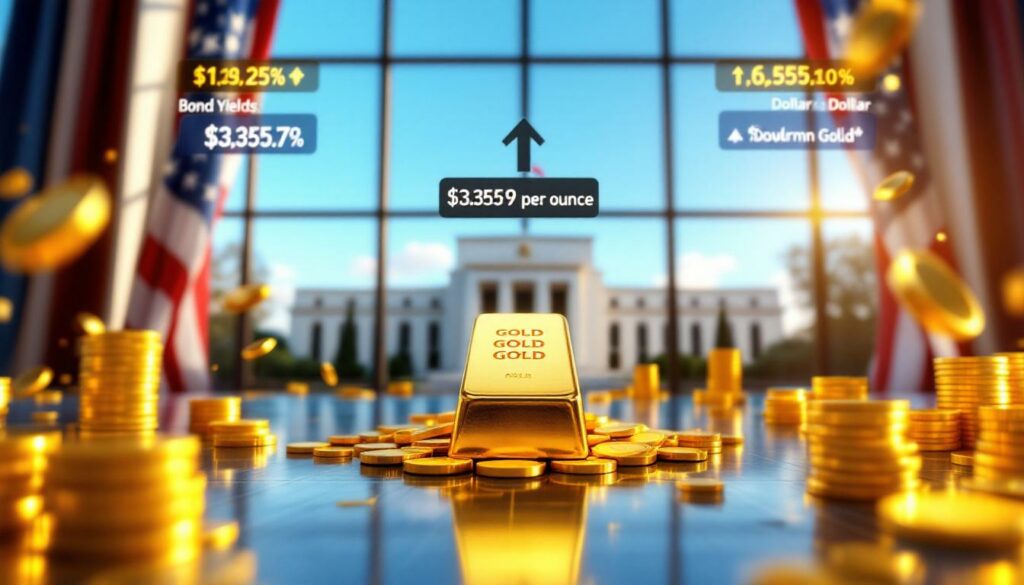How Is the Gold Price Responding to Fed Rate Cut Signals?
Gold markets have shown significant positive movement following key Federal Reserve comments about potential interest rate cuts. The precious metal continues to demonstrate its sensitivity to monetary policy signals, with traders closely watching every statement from Fed officials for hints about future rate adjustments.
Understanding the Gold Price Movement After Waller's Comments
Gold prices surged by 0.7% in immediate reaction to Federal Reserve Governor Christopher Waller's supportive comments regarding a potential July rate cut. This upward momentum pushed the precious metal to $3,353.59 per ounce by 11:19 a.m. in New York on July 18, 2025, highlighting investor confidence in gold as a store of value during periods of monetary policy transition.
The yellow metal has demonstrated remarkable strength throughout 2025, gaining over 25% year-to-date and outperforming many traditional investment vehicles. This impressive performance comes despite economic uncertainties and fluctuating market expectations regarding the Federal Reserve's rate policy.
"Gold's dramatic response to Waller's comments demonstrates the market's heightened sensitivity to any signals suggesting a shift in monetary policy," notes market analyst Jonathan Chen at Precious Metals Research Group.
The price movement coincided with declining bond yields and a weakening dollar, both typical market reactions to expectations of looser monetary policy. This inverse relationship between gold prices analysis 2025 and dollar strength has been particularly pronounced throughout 2025's trading sessions.
What Did Fed Governor Waller Say About Rate Cuts?
In a significant break from typical central bank caution, Federal Reserve Governor Christopher Waller made unusually direct comments about the July meeting, triggering the gold market's positive response.
Waller explicitly indicated he would dissent if his colleagues vote to hold interest rates steady at the upcoming July Federal Open Market Committee (FOMC) meeting. His strong stance on the need for rate cuts underscores growing concerns about the labor market's resilience after recent data showed cooling employment growth.
"If you make it very clear you think at this moment in time this is an important thing to do," Waller stated during a Bloomberg TV interview, explaining the circumstances under which dissent would be appropriate. This rare public declaration of potential dissent highlights the increasing division within the Fed about appropriate monetary policy.
Waller's comments came amid intensifying political pressure, with President Trump repeatedly calling for the Federal Reserve to lower borrowing costs to support economic growth. While the Fed maintains its political independence, these external pressures contribute to the complex environment in which monetary policy decisions are being made.
The timing of Waller's statement is particularly noteworthy as it comes just two weeks before the critical July 30 meeting, giving markets a clearer signal of the internal debates occurring within the Federal Reserve system.
How Are Markets Interpreting Fed Rate Cut Possibilities?
Despite Waller's strong stance favoring a July rate cut, financial markets are showing more skepticism about immediate policy changes. This divergence between Fed commentary and market expectations creates an interesting dynamic for gold investors.
Swap traders, whose activity provides insight into market expectations, are currently assigning near-zero probability for a rate cut at the upcoming July 30 meeting. This cautious market positioning suggests traders believe the Fed may need more economic data before implementing their first rate cut of the cycle.
Looking beyond July, markets are pricing in approximately 45 basis points of easing by year-end 2025. This represents a significant reduction from earlier expectations, as traders had anticipated more than 65 basis points of cuts at the beginning of July. The shift in expectations largely resulted from stronger-than-anticipated June employment data released on July 3, which showed the U.S. economy adding 165,000 jobs, exceeding economist expectations of 145,000.
The evolution of rate cut expectations throughout 2025 can be visualized in the following table:
| Time Period | Expected Rate Cuts (basis points) | Key Influencing Factors |
|---|---|---|
| January 2025 | 25 | Persistent inflation concerns |
| April 2025 | 50 | Mixed economic indicators |
| Early July 2025 | 65+ | Weakening manufacturing data |
| Mid-July 2025 (current) | 45 | Strong June employment report |
This constant recalibration of expectations creates a challenging environment for gold investors trying to position themselves ahead of actual Federal Reserve policy changes.
Why Does Gold Typically Benefit from Rate Cuts?
Gold's traditional response to interest rate cuts is tied to several fundamental economic relationships that make the precious metal particularly attractive in declining rate environments.
Unlike bonds or savings accounts, gold pays no interest to holders. This characteristic, often cited as a disadvantage, becomes a relative strength when interest rates fall. As rates decline, the opportunity cost of holding non-yielding assets like gold decreases significantly, making the metal more competitive against interest-bearing investments.
Lower interest rates typically weaken the U.S. dollar as well, creating a secondary benefit for gold prices. Since gold is priced in dollars internationally, a weaker greenback makes the precious metal less expensive for buyers using other currencies, potentially increasing global demand.
Gold also serves as a traditional gold record highs & inflation hedge against the potential inflation that can follow monetary easing. When central banks cut rates, they effectively increase the money supply, which many investors fear could lead to currency devaluation and higher inflation over time. Historical data shows gold has maintained purchasing power during inflationary periods better than many paper currencies.
- Lower rates reduce the appeal of interest-bearing assets compared to gold
- A weakened dollar makes gold more affordable globally
- Concerns about future inflation drive investors to hard assets
- Central bank diversification from dollars to gold increases during easing cycles
The relationship between gold and interest rates isn't always immediate or predictable, however. Market psychology, geopolitical developments, and economic data can all influence how quickly and strongly gold responds to changes in monetary policy.
What Other Factors Are Influencing Gold Prices in 2025?
While Federal Reserve policy remains a dominant factor in gold's performance, several other key drivers are supporting the precious metal's strong showing in 2025.
Geopolitical tensions have intensified throughout the year, driving investors toward safe haven gold insights. The ongoing trade disputes between major economies and regional conflicts have created significant market uncertainty, traditionally beneficial for gold prices. The metal's stateless nature and universal acceptance make it particularly valuable during periods of international tension.
Concerns about dollar-denominated assets have increased gold's appeal among institutional investors and central banks. Several major economies have announced plans to reduce their dollar reserves in favor of gold, continuing a trend that began in the early 2020s. This structural shift in global reserve management provides ongoing support for gold prices.
Consumer inflation expectations have decreased to 4.4% annually, down from 5% previously, according to the latest University of Michigan survey. While moderating inflation expectations would typically be negative for gold, the current level remains well above the Federal Reserve's 2% target, maintaining inflation concerns as a supportive factor.
"What's remarkable about gold's performance in 2025 is how it's benefiting from both inflation concerns and safe-haven demand simultaneously. This dual support system has created a particularly robust foundation for prices," explains Dr. Sarah Johnson, economist at Global Asset Strategies.
Gold has been trading in a relatively tight range as investors await clarity on several economic and geopolitical factors, but the overall trend remains firmly positive as these multiple supportive factors converge.
How Does Gold Compare to Other Precious Metals?
Gold's performance in 2025 has diverged significantly from other precious metals, highlighting the unique drivers affecting each metal in the current economic environment.
Silver prices have generally moved in tandem with gold, though with more volatility. During the trading session following Waller's comments, silver rose modestly, reflecting its historical role as "gold's little brother." Currently trading at $38.445 per ounce, silver has shown a 0.05% increase, significantly less than gold's 0.7% jump. This performance gap illustrates silver's typically more volatile nature and its greater industrial demand component.
Palladium and platinum both declined following Waller's statements, demonstrating their different market drivers. Palladium fell to $1,295 per ounce, down 1.75%, while platinum dropped to $1,458.9 per ounce, declining 1.45%. These metals are more heavily influenced by industrial demand, particularly from the automotive sector, than by monetary policy considerations.
The comparison between precious metals in 2025 is summarized below:
| Metal | YTD Performance (2025) | Primary Price Drivers | Current Price |
|---|---|---|---|
| Gold | +25% | Monetary policy, safe-haven demand | $3,353.59/oz |
| Silver | +18% | Industrial use, monetary policy | $38.445/oz |
| Platinum | -6% | Automotive demand, industrial applications | $1,458.9/oz |
| Palladium | -12% | Automotive catalysts, industrial demand | $1,295/oz |
The Bloomberg Dollar Spot Index dropped 0.3% following Waller's comments, providing additional support for dollar-denominated commodities. This currency effect benefits all precious metals to some degree, though gold has shown the strongest correlation with dollar movements.
What Are Investors Watching for Future Gold Price Movements?
Sophisticated gold investors are monitoring several key developments that could determine the metal's trajectory through the remainder of 2025 and beyond.
Clarity on U.S. trade negotiations with various global partners tops the watchlist for many market participants. The outcome of these discussions could significantly impact global economic growth and risk sentiment, both important factors for gold demand. Positive resolutions could reduce safe-haven demand, while escalating tensions would likely support higher gold prices.
The Federal Reserve's ultimate decision on the timing and pace of rate cuts remains perhaps the single most important factor for gold prices in the near term. While markets are currently skeptical about a July cut despite Waller's comments, any shift in this expectation could trigger significant price movement in precious metals markets.
Potential impacts of tariffs on the global economy present another important consideration. Several major economies have implemented or threatened new tariff regimes in 2025, creating uncertainty about future trade flows and economic growth. Historical evidence suggests trade barriers typically slow global growth and increase market volatility, conditions that have traditionally benefited gold.
Further developments in geopolitical tensions that could drive safe-haven demand remain a wildcard factor. Current hotspots include:
- Ongoing maritime disputes in Southeast Asia
- Energy security concerns in Europe
- Political transitions in several major economies
- Technology and intellectual property disputes
Consumer and institutional investment trends in precious metals also bear watching. ETF flows into gold-backed products have shown strong momentum in 2025, with assets under management reaching record levels. Any reversal in this trend could signal changing sentiment toward the metal.
For investors looking to capitalize on these trends, understanding different gold investment strategies is crucial in the current market environment, as different approaches may be suitable depending on an investor's time horizon and risk tolerance.
FAQ: Gold Price and Federal Reserve Policy
How much has gold increased in value during 2025?
Gold has climbed more than 25% in 2025, driven by geopolitical tensions, concerns about dollar-denominated assets, and anticipation of potential interest rate cuts. This impressive performance makes gold one of the best-performing major assets this year, outpacing most stock indices and bond markets.
What is the current market expectation for Fed rate cuts in 2025?
Swap traders are pricing in approximately 45 basis points of easing by year-end 2025, down from more than 65 basis points expected at the start of July. This represents between one and two quarter-point cuts before the end of the year, with uncertainty about whether the first cut will come in July, September, or later in the year.
Why did gold prices rise after Waller's comments?
Gold prices increased because Waller's support for a July rate cut pushed bond yields and the dollar lower, making gold more attractive as it typically benefits from lower interest rate environments. The comments reduced the opportunity cost of holding non-yielding assets like gold and potentially accelerated the timeline for monetary easing.
How do interest rates affect gold prices?
Lower interest rates generally benefit gold prices because gold doesn't pay interest. When rates fall, the opportunity cost of holding gold decreases, making it more attractive compared to interest-bearing assets. Additionally, rate cuts typically weaken the dollar, making gold less expensive for international buyers and often raising concerns about future inflation—all factors that support gold prices.
Understanding the gold market outlook & trends can help investors navigate the complexities of the current economic landscape as they position themselves for potential rate cuts and other market-moving events in the months ahead.
Disclaimer: This article contains market analysis and economic forecasts. These predictions are subject to uncertainty and actual outcomes may differ significantly. Readers should conduct their own research before making investment decisions based on this information.
Looking for ASX Gold Stock Opportunities in a Rate-Cut Environment?
Discover promising ASX gold companies ahead of the broader market with Discovery Alert's proprietary Discovery IQ model, which delivers instant notifications on significant mineral discoveries across the ASX. Visit our discoveries page to learn how major gold discoveries have historically generated substantial investor returns.




